by Elizabeth | Jun 27, 2014
 Going to the beach or pool is a popular summer activity but did you know a child can drown in as little as one inch of water? Drowning is usually quick and silent. A child will lose consciousness two minutes after submersion, with irreversible brain damage occurring should the child survive. According to the Consumer Product Safety Commission, at least 350 children die each year from drowning, with most occurring in the summer months.
Going to the beach or pool is a popular summer activity but did you know a child can drown in as little as one inch of water? Drowning is usually quick and silent. A child will lose consciousness two minutes after submersion, with irreversible brain damage occurring should the child survive. According to the Consumer Product Safety Commission, at least 350 children die each year from drowning, with most occurring in the summer months.
Keep an eye on young children and prevent them from drowning. Here are a few points to consider when you are around water:
If you have a pool or spa, install a 4-foot fence around it. Besides lowering your insurance premiums, you will prevent direct access to the pool. Children are curious and move quickly; a “self-locking” latch on the gate provides the best obstacle for young children who might want to jump into the pool.
Install safety drain covers. These devices prevent a body part, hair, or clothing from being trapped by the drain cover. All public and private pools as well as spas are required to be fitted with a drain cover per the Virginia Graeme Baker Pool and Spa Safety Act of 2007. For specifications, visit www.poolsafely.gov.
Supervise your child. The most important preventive tactic is to supervise your child around water at all times. This means actively watching them, keeping them within arms’ reach, and not just glancing up every now and then. Don’t assume they will splash and yell for help if they get into trouble. Children can drown quietly in just a few minutes.
Learn to swim. Children can take formal swimming instruction from the age of four years. Water safety skills are included in the training. Swimming programs are available for younger children and babies, but the emphasis is on building confidence and encouraging the child to enjoy water, rather than teaching them to swim. However, children under age five may not be able to use these skills in an emergency so never rely on this to keep them safe.
Use flotation devices. If you buy personal flotation devices, like inflatable vests, make sure they conform to U.S standards – always check the label. You should think of these devices as something to help familiarize your child with water, not as a safety item. A flotation device is not a replacement for supervision. Always supervise your child, even when they are wearing their personal flotation device, in case they tumble upside-down or slip through the vest.
At the beach: Supervise your child at all times – don’t assume that a beach that was safe in the past is safe now, since the action of waves, weather, and wind can influence depth and currents. If the beach uses a color-coded flag warning system, check the flag color and heed the guidelines. Only take your child to beaches with lifeguard patrols. Make sure your child swims only in the protected area. Teach your child to float and raise an arm to signal for help from a lifeguard.
Going to the beach or pool is a lot of fun – keep it safe and always be alert around children. Have a great and safe summer!
by Melanie Taylor | Jun 2, 2014
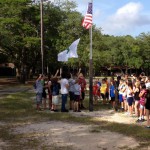
Summer camp teaches children independence and leadership skills.
Summer is here and summer camp is on the horizon. Maybe this is your child’s first time to an overnight camp or they are “old pros” at this thing called camp. Many parents and children will have camp anxieties, but here are some things you can do to prepare your camper and yourself for camp.
Campers:
• Plan several sleepovers before the week of camp arrives. Resist the urge to pack their bags for them or to check on them while there. If they have a cell phone, have them leave it at home. This is a good way to practice not having direct or constant contact.
• Encourage them to write a letter to someone (maybe you) while at camp. You will be so excited when you receive a letter from camp! Be sure to include envelopes, addresses, stamps, paper, and a pen in their luggage.
• Gear up physically. If you have purchased your camper new tennis shoes, have them break them in with a few long walks so the blisters don’t happen at camp.
• Especially for teenagers, have them take a mini-vacation from their electronic devices – a couple of hours or a weekend.
• Have them write a statement for their social media pages. “Peace out Facebook, I will be at camp for the next week. Check in with you when I get back” or something similar.
• Have them write down their goals for camp so they can mentally prepare themselves for what they hope to do and see.
• Make a homesick plan:
1. Homesickness isn’t entirely bad. It’s great to love your home. It’s sometimes part of the process and it’s a confidence-booster when a camper gets through it.
2. Make a “happy place” plan and write it down. This is an amazing opportunity to learn a life skill. Today’s youth go to technology to escape and studies show this increases their stress. Some ideas include: taking 10 deep breaths, traveling to a “happy place” in your mind, packing a certain stuffed animal, or tossing a football. Children are capable of this independence.
3. Your plan should NOT be, “Give it a couple of days and if you don’t like it, we will come get you.” This will set them up to give it a couple of days and knock the confidence right out of them.
4. Let your camper know what to expect with correspondence. You don’t need to write every day but let them know what to expect.
Parents:
• You are giving your child an incredible gift. I cannot promise you they will not lose some socks, they will love every meal or activity, and they will adore every staff member. But you are preparing them for college and beyond; you are giving them the freedom to gain confidence, independence, and leadership skills; and you are instilling in them that they can do it.
• What do YOU want to do during their time at camp? Plan a vacation for a later time, organize the house, or enjoy one-on-one time with your other children or some “date nights” with your spouse or friends.
• If you have apprehensions, work to resolve them. If you are worried your camper is not going to know anyone, set up a pre-camp get-together. If you are worried about your camper’s medical needs, become friendly with the camp staff. If you are anxious about their food allergies, talk to the camp’s director. Make a camper-sick plan for yourself. Make sure there is only excitement and optimism coming from you; share your anxiety with another adult.
• Pack self-addressed stamped envelopes in their luggage.
• Whether they are flying or driving, hold off on crying your eyes out until they cannot see you. Take a deep breath, trust, and remind yourself you are giving them an awesome gift.
And just what is this gift everyone is talking about? At camp, they will be part of a community all their own. They will become emotionally attached to handmade rope bracelets on their wrist, and have a song for any occasion on cue, and maybe even forget they need to shower, and think sunscreen is just a normal daily moisturizing technique. They will learn to do things on their own and they’ll learn to rely on others. They will learn how to survive on their own for a week or two and they’ll learn how to help each other through it.
They may even grow up on summers away from TV and forget Facebook exists. They will relish the joy of sleeping in cabins, swatting mosquitoes at campfire, and swimming every day. They will savor the feeling of pushing water behind them with a paddle and the whoosh of air behind the tail of an arrow as they fire. They’ll forget about appearances, relish tan lines, and recognize the beauty of a smile over anything else.
So send your kids to camp. Send them so they’ll learn to set tables and make beds and wake early. Send them so they’ll know how to be a leader, paddle a kayak, weave a bracelet, and sing as loud as they can. Send your kids to camp so they’ll learn to love themselves and learn to love others. Send your kids to camp because they’ll realize who they are – or who they want to be. And, prepare yourselves for a year of camp stories and for a flurry of songs. Prepare to learn names of kids you’ve never met. And for your kids to have a need for sunshine, campfires, and companionship. They will be forever grateful for your awesome gift of summer camp.
Source:
American Camping Association, Inc. (http://www.acacamps.org)
by Monica Brinkley | Jun 2, 2014
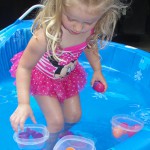
Simple sorting games teach pre-math skills to young children.
Children are born curious and are constantly learning about the world around them. Children learn basic math skills through daily activities and interaction. They practice basic math skills as they notice differences between things, how events happen the same way every time, and how they can make events happen. Many parents push their children to count to ten, but teaching children to count involves more than reciting. It involves helping children understand the meaning of numbers.
Children will learn the meaning of numbers when they are developmentally ready. They might know the numbers in sequence, but are not able to use them to count. In others words, they may count to three and move four objects. Begin counting with children around the age of two to three. This helps children begin to move towards matching one thing at a time with the numbers as they say it.
Three- to four-year-old children are still learning to understand quantity. They usually can count to five and are growing in their understanding of what numbers really mean. By ages four to six, they are counting with meaning, usually matching the numbers one to ten with ten items.
Counting can be fun with your help. There are many fun activities you can do with your children to assist in learning the meaning of counting. Count socks as you sort them; count the juice boxes in the refrigerator or the cars going by. The more experience they are given, the more they will learn the meaning of numbers. Giving your child experience regularly will help them in their understanding of numbers.
To help your child get ready for math, give him/her opportunities to think about patterns and to sort things. Use items you find around the house or outside. Lay out a pattern with items such as a leaf, stick and stone and repeat the pattern. Ask your child to make the same pattern. This is a very simple but fun way to introduce math concepts. Sorting can be done easily when doing household chores. Sorting towels by color, putting small towels in this spot on the shelf and large towels in that spot are just a couple of sorting ideas.
Learning about shapes, space, and measurement are also pre-math skills you can help preschool children develop. Talk about shapes as you are walking or riding down the road. Examples: see the round stop light; this sandwich is square until we cut it in half, it then becomes a triangle. Inches, feet, and other units of measurement don’t make much sense to a young child. However, you can teach a child to measure with objects like a shoe. Have them see how long a rug is with a shoe. Then work up to giving them a ruler to work on measurement problems.
Teaching pre-math skills is easy. Recognize the curiosity in young children and use this as an opportunity to teach in a fun way.
Source: Penn State Extension; Better Kid Care, Math for Every Age.
by Elizabeth | May 28, 2014
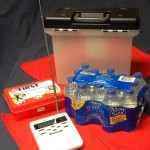 May 25 – 31, 2014 is National Hurricane Preparedness Week.
May 25 – 31, 2014 is National Hurricane Preparedness Week.
This week is a good time to prepare your family, property, and pets for severe weather situations. The dangers of a hurricane are numerous: heavy rainfall, flooding, high winds, tornadoes, and in our coastal areas, high tide and rip currents. UF/IFAS Extension has information to help you prepare for the season.
1. Create a plan for your family. Where can your family go in case of an evacuation? Do you plan to stay put and hunker down until the storm passes? Is your house “secure” enough to sustain high winds?
2. Organize your important papers. When it comes to preparing for weather emergencies, knowing where your important documents are is as important as having a plan for your family. Having all your documents up-to-date, accessible, and portable can make a big difference at a tense time.
3. Check your insurance. Will any of the policies you hold pay for temporary shelter, replacement clothing, furniture, or other items if you are affected by a hurricane? Are floods covered in the policy? What is the amount of your hurricane deductible? Visit the Federal Emergency Management Agency (FEMA) or the Florida Disaster Recovery website for more information. Find out whether you can flood-proof your home now.
4. Plan for your pets. Include the welfare of your pets in your plan. Many public shelters do not allow pets so make arrangements to board your animals. Keep ID tags and vaccinations up to date. Prepare a pet evacuation kit, including food and water for one week, a manual can opener, medications, medical/vaccination records, a pet carrier, and bedding. Planning can help ensure safety for you and your pets during a weather emergency.
Bookmarks for more information:
If a hurricane affects you this year, return to this website for tips on recovery and information about your rights.
by Amy Mullins, PhD, RDN | May 13, 2014
Parents and guardians across America work hard everyday to put food in the mouths of their families. We all have to make choices in the foods we eat and provide for our children. This process of planning, shopping, and preparing healthy meals is challenging, but especially for those that have limited income and resources. These families that struggle for food security put themselves at risk for a host of nutrition-related chronic diseases including obesity, high blood pressure, cardiovascular disease, and diabetes.
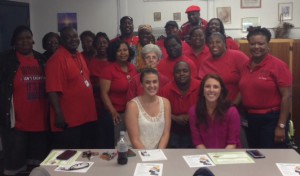
EFNEP teaches families how to shop for healthy foods, plan and cook meals, save money on food purchases, and incorporate physical activity into their lives.
Over 26% of Leon County’s population is living below the poverty level, which is much higher than the 16.5% of Florida’s total population. In addition, a relationship between income level and overweight status has been established. Of the adults in our county that make less than $25,000 per year, over 70% of them are overweight or obese. These are scary statistics that bring the problems of poor nutrition and limited-income to light.
Having access to nutritious food is a good first step toward putting healthy meals on the family’s table. Surprisingly, only 77% of eligible Floridians in 2010 asked for and received assistance through the Supplemental Nutrition Assistance Program (SNAP). Sadly, it seems that a very large number of eligible Floridians are not getting the help that they need to feed their families.
How can parents and caregivers make the most of their food budget and make healthier choices when planning, shopping, and preparing meals? This is where nutrition education can play a key role to ultimately improve the diet and health of the total family. The Expanded Food and Nutrition Education Program (EFNEP) is offered in over 10 counties in Florida, including Leon County, and is designed to empower families to practice and adopt positive nutrition and lifestyle behaviors. Classes are free and consist of a series of 8 interactive lessons that teach adult participants how to shop for healthy foods, plan and cook meals, save money on food purchases, and incorporate physical activity into their lives.
Classes are offered throughout the county at various community sites. If you are interested in starting a class with your group, church, or worksite, or to find out more information about EFNEP, contact Amy Mullins, Registered Dietitian and Family and Consumer Sciences Agent at UF IFAS Leon County Extension, amymullins@ufl.edu or 850-606-5203. Learn more about SNAP eligibility and benefits by visiting http://www.fns.usda.gov/

by Ginny Hinton | May 12, 2014
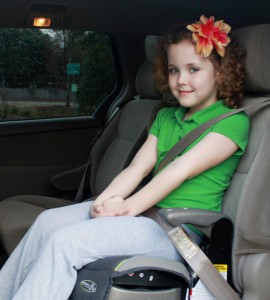
New bill would require booster seats for children four years old through age five.
For several years, Florida has been the most dangerous state for children between the ages of 4 and 10 traveling in vehicles. Florida is currently one of only two states in the nation that lacks a booster seat bill for older children – and the only state that allows 4-year-olds to ride in an adult seatbelt.
Booster seats are needed for the simple reason that seat belts are designed to fit adults – specifically the “average” adult male. When a child under age 8 (on average) or under 4’ 9” tall and 80 pounds sits in an adult seatbelt, the lap belt tends to ride up onto his or her stomach. In a crash the belt tightens to keep the child from being ejected. It cuts through the soft stomach and the first bone to stop it is the spinal cord. This is known as “seat belt syndrome”. It can cause severe injuries including internal bleeding and even paralysis. A booster seat “boosts” the child up about six inches so the belt fits below the stomach and can restrain the child properly without causing injury. Using a booster seat reduces your child’s risk of injury by about 60%.
In Florida, some kids are about to get a safety “boost”. The Florida House and Senate just passed the revisions to Florida Statute 316.613 with Bill 225. If signed by Governor Scott, the new regulations will take effect on January 1, 2015. The new law will require children aged 4 through 5 years old to travel in a car seat or booster, NOT an adult seat belt. Unpaid drivers who are not in the child’s immediate family, children being transported for medical emergencies and children with a medical condition necessitating an exception are exempt from the law.
While this law by no means provides adequate protection for Florida’s older children, it is at least a step in the right direction. By a slim margin, Florida will no longer be the most unsafe state in the nation for child passengers.
 Going to the beach or pool is a popular summer activity but did you know a child can drown in as little as one inch of water? Drowning is usually quick and silent. A child will lose consciousness two minutes after submersion, with irreversible brain damage occurring should the child survive. According to the Consumer Product Safety Commission, at least 350 children die each year from drowning, with most occurring in the summer months.
Going to the beach or pool is a popular summer activity but did you know a child can drown in as little as one inch of water? Drowning is usually quick and silent. A child will lose consciousness two minutes after submersion, with irreversible brain damage occurring should the child survive. According to the Consumer Product Safety Commission, at least 350 children die each year from drowning, with most occurring in the summer months.





